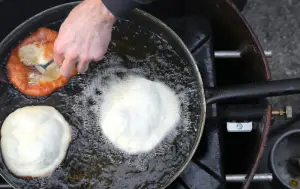Significance in Native American Cuisine
Frybread’s significance in Native American cuisine cannot be overstated. It is more than just food; it is a symbol of survival and adaptability. Often featured at gatherings, powwows, and family meals, frybread connects generations and serves as a reminder of cultural endurance. Its presence at modern-day events and festivals underscores its enduring legacy and the continued importance of traditional foods in Native American culture.
The Tradition of Indian Frybread
The Historical Context of Indian Frybread
Origins and Historical Significance
The story of Indian frybread is deeply rooted in history, dating back to the 19th century. Its creation is tied to the hardships faced by Native Americans, particularly the Navajo Nation, during periods of displacement and forced relocation. The U.S. government’s provision of rationed foodstuffs like flour, sugar, and lard led to the invention of frybread, born out of necessity and ingenuity.
The Navajo Long Walk and its Impact on Frybread
The Navajo Long Walk of the 1860s, a dark chapter in American history, significantly influenced the creation of frybread. As the Navajo people were forcibly removed from their homeland and faced severe food shortages, they utilized the limited ingredients available to them to create this now-iconic bread. Frybread became a symbol of perseverance amidst adversity, a testament to the Navajo’s ability to adapt and endure under the most challenging circumstances. Today, it stands as a poignant reminder of the past while continuing to be a staple in Native American cuisine.
Here’s a basic recipe:
Ingredients
3 cups all-purpose flour
1 tablespoon baking powder
One teaspoon salt
1. cup warm water
Vegetable oil, for frying
Instructions
Mix Dry Ingredients:
In a large mixing bowl, combine the flour, baking powder, and salt.
Add Water:
Gradually stir in the warm water to form a dough. Start with about ¾ cup of water, adding more as needed. The dough should be soft but not sticky.
Knead the dough.
On a lightly floured surface, knead the dough until it becomes smooth and elastic, about 5 minutes.
Rest the Dough:
Cover the dough with a clean cloth and let it rest for at least 30 minutes. This allows the gluten to relax and makes the dough easier to handle.
Heat Oil:
In a large skillet or deep fryer, heat about an inch of vegetable oil to 350°F (175°C).
Form and Fry:
Divide the dough into balls (about golf ball size). On a lightly floured surface, flatten each ball into a disk, roughly ¼ inch thick and about 6–8 inches in diameter. You can make a small hole in the center of each disk to ensure even cooking.
Fry the breads one at a time, turning once, until they are golden brown on both sides. This usually takes about 2–3 minutes per side.
Drain:
Remove the frybread from the oil and drain on paper towels.
Serve:
Serve warm. Indian Frybread can be enjoyed as is or topped with various ingredients such as honey, jam, powdered sugar, or savory toppings like taco fixings for an Indian Taco.
Conclusion
In summary, Indian Frybread is not just a culinary delight but a symbol of resilience and cultural identity within Native American communities. Its rich history and diverse variations reflect the adaptability and creativity of these communities. As you explore the world of Indian Frybread, you’re not only indulging in a delicious treat but also connecting with a significant part of Native American heritage. Whether you’re trying a traditional recipe or a modern adaptation, each bite of frybread invites you to appreciate and celebrate the enduring spirit and rich traditions of Native American cultures.


